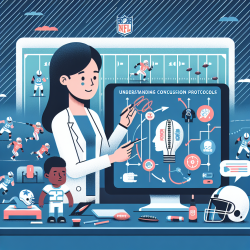Introduction
In the realm of child development and safety, the built environment plays a crucial role. A recent study, "The built environment and active transportation safety in children and youth: a study protocol," sheds light on how modifications to urban spaces can significantly impact children's safety and their propensity to engage in active transportation, such as walking or biking to school. As practitioners dedicated to creating optimal outcomes for children, understanding and implementing these findings can be transformative.
Key Findings from the Study
The research highlights several critical aspects of the built environment that influence children's safety and active transportation habits:
- Traffic Calming Features: Implementing speed bumps, roundabouts, and other traffic calming measures can reduce the risk of pedestrian and bicyclist injuries.
- Separated Bike Lanes: Providing dedicated lanes for bicyclists can lower the incidence of accidents and encourage more children to bike to school.
- Urban Design: Factors such as population density, land use diversity, and the presence of recreational facilities contribute to safer and more appealing environments for active transportation.
Implications for Practitioners
As a practitioner, integrating these insights into your work can enhance child safety and promote healthier lifestyles. Here are some actionable steps you can take:
- Advocate for Infrastructure Changes: Work with local governments and community organizations to implement traffic calming measures and create safer routes for children.
- Educate Parents and Communities: Raise awareness about the benefits of active transportation and the importance of a supportive built environment.
- Conduct Further Research: Collaborate with researchers to study the specific needs and challenges of your community, ensuring that interventions are tailored and effective.
Encouraging Further Research
The study provides a robust framework for understanding the relationship between the built environment and child safety. However, it also highlights the need for further research, particularly in diverse urban settings. Practitioners are encouraged to engage in or support studies that explore:
- The impact of specific urban design features on child safety and active transportation.
- Longitudinal studies to track the effectiveness of implemented changes over time.
- Cross-disciplinary collaborations to integrate insights from urban planning, public health, and child development.
Conclusion
By understanding and applying the findings of this study, practitioners can play a pivotal role in shaping safer, more active communities for children. The potential to reduce injuries and promote healthier lifestyles is significant, making this an essential area of focus for those committed to improving child outcomes.
To read the original research paper, please follow this link: The built environment and active transportation safety in children and youth: a study protocol.










